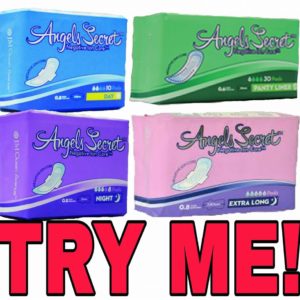
Menstruation is an uncomfortable topic made worse when many of the products women must use contain known cancer-causing carcinogens. Its time for some Real Truth
No one wants to discuss feminine hygiene products. Not ever.
It’s usually embarrassing and the topic can make even the strongest woman incredibly uncomfortable. Mothers purchase their daughters’ products and pray for them to read the directions instead of asking questions.
But with studies questioning how these goods are made and what toxins they contain, women have new information to consider. The dangers sanitary products pose is a real concern. Ignoring them can lead to bigger health problems in the future.
Could Your Pad or Tampon be Harming You?
How can a clean, white pad or tampon cause damage? Consider whether or not that tampon is made with organic cotton. If not, chances are that it’s made with GMO cotton treated with crop pesticides. It’s a fact that 94% of the cotton grown in the United States is genetically modified.
If it’s an “odor neutralizing” product or contains any sort of fragrance, it contains a chemical soup of contaminates that can potentially cause infertility, neurological defects, hormone dysfunction, and cancer.
The average woman will use between 16,000 and 24,000 tampons in her lifetime, depending on how long her body menstruates. Without the ability to rid these toxins absorbed topically, they accumulate over a lifetime.
Tampons can also create an ideal environment for bacteria to develop and thrive. The walls of the vagina are so thin and delicate that regular use of feminine hygiene products can cause micro-tears. This presents a perfect breeding ground for bacteria. Toxic Shock Syndrome (TSS) is a potentially life threatening condition caused by either a strep or staph infection resulting from tampon use.
Do you wonder why feminine hygiene products are so bright white? In order to get that pure white look, manufacturers use chlorine bleach. A by-product that forms from this bleaching process is dioxins. The Environmental Protection Agency (EPA) recognizes dioxins as a serious threat to public health and determined that there is no safe level of exposure.
However, the Federal Food and Drug Administration (FDA) states that there is no discernible threat to the health of tampon or pad users from these dioxins as they are below detectable limits. They believe that “trace amounts” of dioxins are acceptable and safe to the human body.
If you use a product on your skin as much as 24,000 times during your life, is that considered a “trace amount” by the FDA? Clearly, the cancer-causing effects of these toxins are of very little concern to a government agency that long ago stopped caring about long-term consumer health.
Alternative Feminine Hygiene Products to Consider
There are alternatives that you can choose to lessen your exposure to the materials contained in various feminine hygiene products and nursing pads.
- Organic cotton tampons. These products must pass an absorbency test so you are not likely to find any reduction in the quality. Organic tampons continue to test well beneath detectable levels for toxins. Look for 100% organic on the label. Click Here For Organic Products
- Organic sanitary pads. Available online, these pads are a safe alternative to traditional pads. Again, absorbency is regulated so you are not losing quality by choosing a safer product. Angels Secret Sanitary Napkins
Source: https://thetruthaboutcancer.com

